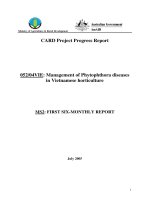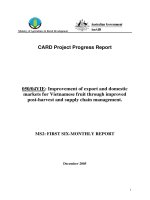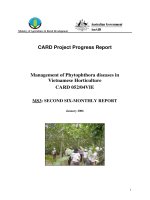Báo cáo nghiên cứu khoa học: " EXISTENCE OF SOLUTIONS OF SET CONTROL DIFFERENTIAL EQUATIONS" doc
Bạn đang xem bản rút gọn của tài liệu. Xem và tải ngay bản đầy đủ của tài liệu tại đây (342.09 KB, 10 trang )
TẠP CHÍ PHÁT TRIỂN KH&CN, TẬP 10, SỐ 06 - 2007
Trang 5
EXISTENCE OF SOLUTIONS OF
SET CONTROL DIFFERENTIAL EQUATIONS
Nguyen Dinh Phu, Tran Thanh Tung
University of Natural Sciences, VNU-HCM
(Manuscript received on June 06
th
, 2006; Manuscript received on May 11
th
, 2007)
ABSTRACT: Recently, the field of differential equations has been studying in a very
abstract method. Instead of considering the behaviour of one solution of a differential equation,
one studies its sheaf-solution (see[8]). Instead of studying a differential equation, one studies
differential inclusion (see[10]). Specially, one studies set differential equation ( a differential
equation whose variables and derivative are sets,( see[1-7]), a fuzzy differential equation is
generalized to be fuzzy control differential equation (FCDE), (see[13]).
In this paper, a set differential equation is generalized to be set control differential
equation (SCDE) and we present the existence and comparison of solutions of (SCDE).This
paper is a continuation of our works in this direction (see [11-15]).
Keywords: Differential equations; Set differential equations; Set control differential
equations.
1. INTRODUCTION
In [1-8], authors studied the existence and comparison of solutions of the set differential
equation (SDE)
H
D X(t) F(t,X(t))=
,
where
=∈ ∈
nn
cc
X(t ) X K (R ),X(t) K (R ),
00
[
]
+
∈=⊂tt,T IR
0
and
×→
nn
cc
F :I K (R ) K (R ).
In this paper, we give the so-called set control differential equation (SCDE) in the form
H
D X(t) F(t,X(t),U(t))= ,
where
=∈ ∈
nn
cc
X(t ) X K (R ),X(t) K (R ),
00
∈
p
c
U( t) K ( R ),
[
]
+
∈=⊂tt,T IR
0
××→
np n
cc c
F :I K (R ) K (R ) K (R ),
and study existence of solutions and comparison solutions of SCDE.
The paper is organized as follows: we recall some basic concepts and notations which are
useful in next sections in section 2 and some results on SDE in section 3. Existence results on
solutions and comparison of solutions of SCDE are presented in section 4.
2. PRELIMINARIES
We recall some notations and concepts presented in detail in recent series works of V.
Lakshmikantham et al. See [1-8].
Science & Technology Development, Vol 10, No.06 - 2007
Trang 6
Let
n
C
K
(R )
denote the collection of all nonempty, compact and convex subsets of
n
R
.
Given
A
,B in
n
C
K
(R ). The Hausdorff distance between A and B defined as
[]
{
}
max sup inf sup inf
aA bB bB aA
DA,B a b, a b
∈∈ ∈ ∈
=−−, (2.1)
where
.
denotes the Euclidean norm in
n
R
.
It is known that
(
)
n
C
K
(R ),D is a complete metric space and if the space
n
C
K
(R ) is
equipped with the natural algebraic operations of addition and nonnegative scalar multiplication,
then
n
C
K
(R )
becomes a semilinear metric space which can be embedded as a complete cone
into a corresponding Banach space. See [15].
The Hausdorff metric satisfies some below properties.
[]
DA C,B C DA,B
⎡⎤
++=
⎣⎦
and
[
]
[
]
DA,B DB,A
=
, (2.2)
[]
DA,B DB,A
⎡⎤
λλ =λ
⎣⎦
, (2.3)
[]
D A,B D A,C D C,B
⎡⎤ ⎡⎤
≤+
⎣⎦ ⎣⎦
, (2.4)
[][]
DA A',B B' DA,B D A',B'
⎡
⎤
++≤ +
⎣
⎦
(2.5)
for all
∈
n
c
A
,B,C K ( R ) and R
+
λ∈
Let
∈
n
c
A
,B K (R )
. The set
∈
n
c
CK(R)
satisfying
A
BC
=
+ is known as the
geometric difference of the sets A and B and is denoted by the symbol
A
B
−
. Given an interval
[
]
+
=⊂It,T R
0
. Function
→
n
c
F:I K(R )
is said to be continuous at t* I∈ if for every
ε>0 there exists a (,t*)δ=δε >0 such that
⎡⎤
<ε ∈ − <δ
⎣⎦
for all withDF(t),F(t*) t I t t* .
We say that the mapping
F has a Hukuhara derivative
τ
H
DF( ) at a point τ∈I , if
→+
τ+ − τ
h
F( h) F( )
lim
h
0
and
→+
τ
−τ−
h
F( ) F( h)
lim
h
0
exist in the topology of
n
C
K
(R ) and are equal to
τ
H
DF( )
.
The Hukuhara integral of F is given by
⎧⎫
=
⎨⎬
⎩⎭
∫∫
is a continuous selector of
II
F(s)ds f(s)ds : f F
for any compact set
+
⊂IR.
We have the following properties of the Hukuhara integral.
TẠP CHÍ PHÁT TRIỂN KH&CN, TẬP 10, SỐ 06 - 2007
Trang 7
If
→
n
c
F:I K(R )
is integrable, one has
=+ ≤≤
∫∫∫
ttt
ttt
F(s)ds F(s)ds F(s)ds, t t t
212
001
012
(2.6)
and
λ=λ λ∈
∫∫
tt
tt
F(s)ds F(s)ds, R
00
.
If
→
n
c
F,G : I K (R )
are integrable, then
[
]
→D F(.),G(.) : I R
is integrable and
⎡⎤
⎡
⎤
≤
⎢⎥
⎣
⎦
⎢⎥
⎣⎦
∫∫ ∫
tt t
tt t
D F(s)ds, G(s)ds D F(s),G(s) ds
00 0
. (2.7)
Let us denote
{}
⎡⎤
θ= = ∈
⎣⎦
n
DA, A sup a:a A
for
∈
n
c
A
K(R ), where θ
n
is the zero element of
n
R
which is regarded as a one point set.
More details in continuity, Hukuhara derivative, Hukuhara integral of the mapping
→
n
c
F:I K(R )
, please see [1-8].
3. SET DIFFERENTIAL EQUATION
In [1-8], authors considered the set differential equation (SDE) as following.
=
H
D X(t) F(t,X(t)), (3.1)
where
[
]
=∈ ∈ ∈ =
nn
cc
X(t ) X K (R ),X(t) K (R ),t t ,T I
00 0
, state ∈
n
c
X(t) K (R )
and
×→
nn
cc
F :I K (R ) K (R )
.
The mapping
⎡⎤
∈
⎣⎦
p
c
XCI,K(R)
1
is said to be a solution of (3.1) on
I
if it satisfies (3.1)
on
I . Since X(t) is continuously differentiable, we have
=+ ∈
∫
t
H
t
X(t) X D X(s)ds, t I
0
0
.
We associate with the initial value problem (3.1) the following
=+ ∈
∫
t
t
X(t) X F(s,X(s))ds, t I
0
0
(3.2)
where the integral is the Hukuhara integral. Observe that
X(t) is a solution of (3.1) if only if it
satisfies (3.2) on
I .
We recall some results in [1-8].
Science & Technology Development, Vol 10, No.06 - 2007
Trang 8
The local existence result on solution of SDE is the following.
Theorem 3.1. Assume that
(i)
⎡⎤
∈
⎣⎦
n
c
FCR,K(R),
0
[
]
θ≤
n
D F(t,X(t)), M ,
0
on
=
×RIB(X,b)
00
where
[
]
{
}
=∈ ≤
n
c
B(X ,b) X(t) K (R ) : D X(t),X b
00
and
(ii)
[]
+
∈⎡× ⎤
⎣⎦
g
CI ,b,R ,02
≤
≤
g
(t,w) M
1
0 on
[
]
×
=I,b,g(t,),02 0 0
g
(t,w) is
nondecreasing in w for each
∈tI
and
≡
w( t ) 0
is the unique solution of
=w' g(t,w) , w(t
0
) = 0 on I. (3.3)
(iii)
(
)
⎡⎤
⎡
⎤
≤
⎣
⎦
⎣⎦
D F(t,X(t)),F(t,X(t)) g t,D X(t),X(t)
on R
0
.
Then, the (3.1) has a unique solution
=
X(t) X(t,X )
0
on
[
]
+ηt,t
00
, where
{
}
η=
b
min a, ,
M
{
}
=
M
max M ,M
01
.
The global existence result on solution of SDE is as follows.
Theorem 3.2. Assume that
+
⎡
⎤
∈×
⎣
⎦
nn
cc
FCR K(R),K(R)and
[]
⎡
⎤
θ≤ θ
⎣
⎦
nn
D F(t,X(t)), g(t,D X(t), ),
+
∈×
n
c
(t,X(t)) R K (R )
,
where
++
⎡⎤
∈
⎣⎦
g
CR,R
2
,
g
(t,w) is nondecreasing in w for each
+
∈
tRand the maximal
solution
r( t, t , w )
00
of
=w' g(t,w)
, w(t
0
)=w ≥
0
0exists on
[
)
+
∞t,
0
. Suppose further that F is smooth
enough to guarantee local existence of solution of (3.1) for any
+
∈×
n
c
(t ,X ) R K (R )
00
. Then
the largest interval of existence of any solution
=
X(t) X(t,t ,X )
00
of (3.1) such that
[]
θ≤
n
DX, w
00
is
[
)
+∞t,
0
.
The below theorem is an existence result on solutions of SDE.
Theorem 3.3. Assume that
+
⎡
⎤
∈×
⎣
⎦
nn
cc
FCR K(R),K(R)and
(i)
[]
⎡
⎤
θ≤ θ
⎣
⎦
nn
D F(t,X(t)), g(t,D X(t), ),
[
]
∈×
n
c
(t,X(t)) t ,T K (R )
0
,
where
[]
++
⎡⎤
∈×
⎣⎦
g
Ct,T R,R
0
,
g
(t,w) is nondecreasing in (t,w);
(ii) the maximal solution
r( t, t ,w )
00
of
=w' g(t,w) , w(t
0
)=w ≥
0
0
exists on I.
Then there exists a solution
=
X(t) X(t,t ,X )
00
to the (3.1) which satisfies
TẠP CHÍ PHÁT TRIỂN KH&CN, TẬP 10, SỐ 06 - 2007
Trang 9
[]
[
]
≤∈ =θ
n
D X(t),X r(t,w ),t I, where w D X , .
00 00
Some results on comparison of solutions of SDE and stability of solutions of SDE were
studied in [1, 4, 5].
4. MAIN RESULTS
In this paper, we provide a set control differential equation (SCDE) as following
=
H
D X(t) F(t,X(t),U(t))
,
=∈
n
c
X(t ) X K (R ),
00
(4.1)
where
××→
np n
cc c
F :I K (R ) K (R ) K (R )
, state
∈
n
c
X(t) K (R ),
control
∈
p
c
U( t ) K ( R ) .
The
→
p
c
U:I K(R ) is integrable, is called an admissible control. Let U be a set of all
admissible controls. The mapping
⎡
⎤
∈
⎣
⎦
n
c
XCI,K(R)
1
is said to be a solution of (4.1) on I if
it satisfies (4.1) on I. Since
X(t) is continuously differentiable, we have
=+ ∈
∫
t
H
t
X(t) X D X(s)ds,t I.
0
0
We associate with the initial value problem (4.1) the following
=+ ∈
∫
t
t
X(t) X F(s,X(s),U(s))ds,t I
0
0
where the integral is the Hukuhara integral. Observe that
X(t)
is a solution of (4.1) if only
if it satisfies (4.2) on I.
Now, based on the theorems 3.1-3.3 of SDE we have some existence results on solutions of
SCDE.
Firstly, we have a unique existence of solution of SCDE as following.
Theorem 4.1. Assume that
(i)
⎡⎤
∈
⎣⎦
n
c
FCR,K(R),
0
[
]
θ≤
n
D F(t,X(t),U(t)), M ,
0
on
=× ×U
R
IB(X,b) ,
00
where
[
]
{
}
=∈ ≤
n
c
B(X ,b) X(t) K (R ) : D X(t),X b
00
and
(ii)
[]
+
∈⎡× ⎤
⎣⎦
g
CI ,b,R ,02
≤
≤
g
(t,w) M
1
0 on
[
]
×
=I,b,g(t,),02 0 0
g
(t,w) is
nondecreasing in w for each
∈
tI and
≡
w( t ) 0 is a unique solution of
=w' g(t,w)
, w(t
0
)=0 on I. (4.3)
(iii)
(
)
⎡⎤
⎡
⎤
≤
⎣
⎦
⎣⎦
D F(t,X(t),U(t)),F(t,X(t),U(t)) g t,D X(t),X(t) on
R
0
.
Science & Technology Development, Vol 10, No.06 - 2007
Trang 10
Then, the (4.1) has a unique solution
=
X(t) X(t,X ,U(t))
0
on
[
]
+ηt,t
00
, where
{
}
η=
b
min a, ,
M
{
}
=
M
max M ,M
01
.
Proof. Function
U( t ) is of variable t . Set
=
h(t,X(t)) F(t,X(t),U(t)) plays the
role of function
F( t, X( t )) in theorems 3.1 and consider U( t ) as parameter, then using
theorems 3.1, we have theorem 4.1.
Then, we have the global existence of solution of SCDE as below.
Theorem 4.2. Assume that
+
⎡
⎤
∈× ×
⎣
⎦
npn
ccc
FCR K(R)K(R),K(R)
and
[]
⎡
⎤
θ≤ θ
⎣
⎦
nn
D F(t,X(t),U(t)), g(t,D X(t), ),
+
∈
××U
n
c
(t,X(t),U(t)) R K (R ) ,
where
g
(t,w) is nondecreasing in w for each
+
∈
tR and the maximal solution
r( t, t ,w )
00
of
=w' g(t,w) , w(t
0
) =w ≥
0
0
exists on
[
)
+
∞t,
0
. Suppose further that f is smooth enough to guarantee local existence of
solution of (4.1) for any
+
∈
××U
n
c
(t ,X ,U(t )) R K (R )
00 0
. Then the largest interval of
existence of any solution
=
X(t) X(t,t ,X ,U(t))
00
of (4.1) such that
[]
θ≤
n
DX, w
00
is
[
)
+∞t,
0
.
This theorem also holds for
⎡⎤
=
>
⎣⎦
J
t,T ,T t
00
.
Proof. Using theorem 3.2 and the proof is similar the proof of theorem 4.1.
We adapt theorem 3.3 of SDE to below theorem of SCDE.
Theorem 4.3. Assume that
+
⎡
⎤
∈× ×
⎣
⎦
npn
ccc
FCR K(R)K(R),K(R)and
(i)
[]
⎡
⎤
θ≤ θ
⎣
⎦
nn
D F(t, X( t),U(t)), g(t,D X( t), ),
[
]
∈× ×U
n
c
(t,X(t),U(t)) t ,T K (R )
0
,
where
[
]
+
+
⎡⎤
∈×
⎣⎦
g
Ct,T R,R
0
,
g
(t,w) is nondecreasing in (t,w);
(ii) the maximal solution
r( t, t ,w )
00
of
=w' g(t,w) , w(t
0
)=w ≥
0
0
exists on I.
Then there exists a solution
=
X(t) X(t,t ,X ,U(t))
00
to the (4.1) which satisfies
[]
[
]
≤∈ =θ
n
D X(t),X r(t,w ),t I, where w D X , .
00 00
TẠP CHÍ PHÁT TRIỂN KH&CN, TẬP 10, SỐ 06 - 2007
Trang 11
For comparison solutions of SCDE we need the following assumption.
Assumption
np n
cc c
F :R K (R ) K (R ) K (R )××→
satisfies the condition
{
}
⎡⎤⎡⎤⎡⎤
≤+
⎣⎦⎣⎦⎣⎦
D F(t,X(t),U(t)),F(t,X(t),U(t)) c(t) D X(t),X(t) D U(t),U(t)
(4.
4)
For
np
cc
t I;X(t),X(t) K (R );U(t),U(t) K (R )∈∈ ∈, where c( t ) is a positive and
integralble on
I .
Let
T
t
Cc(t)dt=
∫
0
. Because c( t ) is integrable on I , it is bounded almost everywhere by a
positive constant
K
.
Theorem 4.4 Suppose that
F satisfies assumption (4.4) and X(t),X(t) are solutions of
SCDE (3.1) starting at
X,X
00
and of U( t),U( t) , respectively. Then one has
⎡⎤ ⎡⎤ ⎡⎤
≤ε ≤δ ε ≤δε
⎣⎦ ⎣⎦ ⎣⎦
D X(t),X(t) if D U(t),U(t) ( ) and D X ,X ( )
00
.
Proof.The solutions of SCDE (3.1) for controls
U( t),U(t ) originating at X,X
00
,
respectively, are equivalent to the following integral forms
t
t
X(t) X F(s,X(s),U(s))ds=+
∫
0
0
t
t
X(t) X F(s,X(s),U(s))ds=+
∫
0
0
.
We estimate
tt
tt
DX(t),X(t)
D X F(s,X(s),U(s))ds,X F(s,X(s),U(s))ds
⎡⎤
⎣⎦
⎡⎤
=+ +
⎢⎥
⎢⎥
⎣⎦
∫∫
00
00
tt
tt
D X ,X D F(s,X(s),U(s))ds, F(s,X(s),U(s))ds
⎡
⎤
⎡⎤
≤+
⎢
⎥
⎣⎦
⎢
⎥
⎣
⎦
∫∫
00
00
t
t
D X ,X D F(s,X(s),U(s)),F(s,X(s),U(s)) ds
⎡⎤⎡ ⎤
≤+
⎣⎦⎣ ⎦
∫
0
00
{
}
t
t
D X ,X c(s) D X(s),X(s) D U(s),U(s) ds
⎡⎤ ⎡ ⎤⎡ ⎤
≤+ +
⎣⎦ ⎣ ⎦⎣ ⎦
∫
0
00
Science & Technology Development, Vol 10, No.06 - 2007
Trang 12
tt
tt
D X ,X c(s)D X(s),X(s) ds c(s)D U(s),U(s) ds
⎡⎤ ⎡ ⎤ ⎡ ⎤
≤+ +
⎣⎦ ⎣ ⎦ ⎣ ⎦
∫∫
00
00
.
⎡⎤ ⎡⎤
≤δε ≤δε
⎣⎦ ⎣⎦
If andDU(t),U(t) () DX,X ()
00
, then
()
t
t
D X(t),X(t) K ( ) c(s)D X(s),X(s) ds
⎡⎤ ⎡ ⎤
≤+δε+
⎣⎦ ⎣ ⎦
∫
0
1 .
Here we have used (2.5), (2.7).
Using Gronwall inequality, we have
()
DX(t),X(t) K ()exp(C)
⎡⎤
≤+δε
⎣⎦
1
.
It follows the proof if we choose
()
()()
K
exp C
ε
<δ ε ≤
+
0
1
.
5. CONCLUSION
In this paper we gave a new concept of set control differential equation and studied its
existence of solutions. A comparison of two solutions was considered. Some more results on
existence and comparison of solutions of set control differential equation will be presented in
next works.
TẠP CHÍ PHÁT TRIỂN KH&CN, TẬP 10, SỐ 06 - 2007
Trang 13
SỰ TỒN TẠI NGHIỆM CỦA PHƯƠNG TRÌNH VI PHÂN ĐIỀU KHIỂN TẬP
Nguyễn Đình Phư, Trần Thanh Tùng
Trường Đại học Khoa học Tự Nhiên, ĐHQG -HCM
TÓM TẮT: Gần đây, lĩnh vực phương trình vi phân đã được nghiên cứu một cách trừu
tượng hơn. Thay vì khảo sát dáng điệu của một nghiệm, người ta đã khảo sát một bó nghiệm (tập
hợp các nghiệm). Thay vì nghiên cứu một phương trình vi phân, người ta nghiên cứu một bao vi
phân (xem [10]). Đặc biệt, người ta đã nghiên c
ứu phương trình vi phân đa trị (tập) là phương
trình vi phân mà cả biến và đạo hàm của nó đều là các tập hợp (xem [1-8]). Trong bài báo này,
chúng tôi tổng quát hoá phương trình vi phân đa trị thành phương trình vi phân điều khiển đa
trị, trình bày sự tồn tại nghiệm và so sánh các nghiệm của nó. Bài báo này là sự tiếp nối của các
công trình của chúng tôi về hướng nghiên cứu này (xem [11-15]).
Từ khoá: Phương trình vi phân, Phương trình vi phân tập; Phương trình vi phân điều
khiển tập.
REFERENCES
[1]. Gnana Bhaskar T, Vasundhara Devi J, Stability criteria for set differential equations, J.
Mathematical and computer modelling, Vol 4, pp1371-1378, (2005).
[2]. Gnana Bhaskar T, Lakshmikantham V, Vasundhara Devi J; Nonlinear variation of
parameters formula for set differential equations in a metric space, J. Nonlinear
Analysis, Vol 63, pp 735-744, (2005) .
[3]. Galanis G. N, Gnana Bhaskar T, Lakshmikantham V, Palamides P.K; Set value
functions in Frechet spaces: Continuity, Hukuhara differentiability and applications to
set differential equations, J. Nonlinear Analysis Vol 61, pp 559- 575, (2005).
[4]. Lakshmikantham V; Set differential equations versus fuzzy differential equations, J.
Applied Mathematics and Computation, Vol 164, pp 277-294, (2005).
[5]. Lakshmikantham V, Gnana Bhaskar T, Vasundhara Devi J; Theory of set differential
equations in metric spaces, Cambridge Scientific Publisher, UK, (2006).
[6]. Lakshmikantham V, Mohapatra R; Theory of fuzzy differential equations and
inclusions, Taylor & Francis, London, (2003).
[7]. LakshmikanthamV., Leela S; Fuzzy differential systems and the new concept of
stability, J. Nonlinear Dynamics and Systems Theory, 1(2), pp 111-119, (2001).
[8]. LakshmikanthamV., Leela S., Vatsala A. S; Interconnection between set and fuzzy
differential equations, J. Nonlinear Analysis, Vol 54, pp 351-360, (2003).
[9]. Phu N. D; Genaral views in theory of systems, VNU–Publishing House, HCM City,
(2003).
[10]. Phu N.D., Huong N.T; Multivalued Differential Equations, VNU – Publishing House,
HCM City, (2005).
Science & Technology Development, Vol 10, No.06 - 2007
Trang 14
[11]. Phu N. D, Tung T.T; Sheaf optimal control problems in fuzzy type, J. Science and
Technology Development, Vol 8 (12), pp 5 -11, (2005).
[12]. Phu N. D, Tung T.T; The comparison of sheaf- solutions in fuzzy control problems, J.
Science and Technology Development, Vol 9 (2), pp 5 -10, (2006).
[13]. Phu N. D., Tung T.T., Some Results on Sheaf solutions of Sheaf fuzzy Control
Problems, Electronic Journal of Differential Equations Vol (2006), N.108, pp 1- 8.
[14]. Phu N. D., Tung T.T., Some Properties of Sheaf solutions of Sheaf set Control
Problems, J. Nonlinear Analysis, Vol 67(2007), pp 1309-1315.
[15]. Phu N. D., Tung T.T, Existence of Solutions of Fuzzy Control Differential Equations, J.
Science and Technology Development (In Press).
[16]. Tolstonogov. A; Differential Inclusions in Banach Space, Kluwer Academic
Publishers, Dordrecht, (2000).









